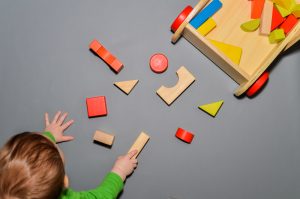 Hand strength and dexterity contribute to your baby’s overall strength, coordination, and ability to play with a variety of objects and toys. Without strong hands and fine-tuned finger movements, your baby might struggle to pick up his stuffed animal on the floor or hold his bottle. Later, he might have a hard time holding a fork, combing his hair, or buttoning his pants.
Hand strength and dexterity contribute to your baby’s overall strength, coordination, and ability to play with a variety of objects and toys. Without strong hands and fine-tuned finger movements, your baby might struggle to pick up his stuffed animal on the floor or hold his bottle. Later, he might have a hard time holding a fork, combing his hair, or buttoning his pants.
Fortunately, there are so many ways you can help your baby’s hands get stronger and more mobile – and it’s never too early to get started!
|
Highlights:
|
Helping Your Baby Build Hand Strength
The first step in building your baby’s hand muscles is to be aware of any warning signs that signal poor hand strength and dexterity so you can voice your concerns to his pediatrician. In this article you can read more about important hand and finger skill milestones for baby’s first year of life.
Hand-Strengthening Activities
There are many ways for babies to develop hand strength and dexterity, even when they’re not yet sitting up on their own. For young babies, lying under a play mat with dangling toys or having toys nearby during tummy time still offers a lot of reaching, grabbing, and manipulating opportunities. Keep in mind that putting toys within his reach in front of and on both sides of him will help him get equal time using each hand. Giving him toys in a variety of shapes, like soft square blocks and circular tug toys, can also help him learn how to rotate and move different objects.
Once your baby starts sitting up, it’s time for stacking blocks and toys to stack (food storage containers are perfect for this!) and puzzles. You can also give him crayons and a coloring book or paper and watch his inner artist bud while strengthening his hands.
Playing with your baby is the best way to keep him engaged with what he’s doing. Join in the fun by shaking a rattle or squeezing a squeaky ball. There’s a good chance your baby will try to mimic everything you do.
Do Mobile Devices Help?
When your baby uses a phone, tablet, or handheld gaming system to tap, scroll or swipe, he’s using his fingers to complete each task. However, these devices don’t offer him the ability to use a wide range of finger and hand motions necessary to build fine motor skills. They could even take away precious time from developing these skills through play.
The American Academy of Pediatrics recommends no screen time for babies under 18 months except for video chats with family or others who are close to the child. The best way for your baby to learn how to use his hands is through hands-on play and structured activities focused on fine motor development. You can find plenty of stacking, grasping, coloring, and other fine motor activities for your baby in the BabySparks app (and he won’t need to use your phone to do them!).
Once hand strength and dexterity begin to develop and stay on track, there’s no stopping what your baby can do. Learn more about how hands develop in your baby’s second year to keep him moving his fine motor skills forward.








